<Main results to date>
1) We found that gentle gradient lakeshores provide a wide range of thermal
conditions, suggesting that
fish can choose tempertures to alleviate stress associated with unfavorable
water temperatures, and
thus reduce susceptibility to KHV (Yamanaka et al., 2010).
2) We established an innnovative method to quantitatively detect KHV in
natural environments
(Minamoto et al., 2009 (Fig.3);Honjo et al., 2010). The method revealed that since it was first
detected in 2003, KHV is now found throughout the Lake Biwa ecosystem, including in plankton and
sediment, lagoons and ponds, and now in almost all the rivers in Japan.
We demonstrated that
it is impossible to eliminate KHV, but that precautionary environmental
management can eliminate
"fertile" disease environments.
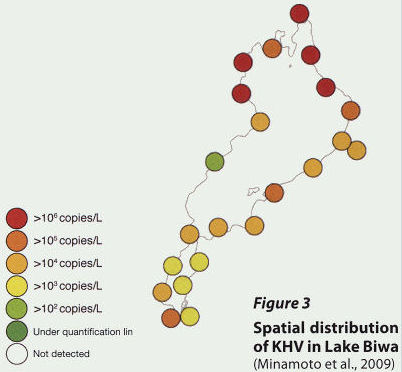 |
3) We have developed a preliminary break-through method allowing determination
of the number and
location of carp in their natural environments.
4) We found that breeding habitats can became hot spots for transmission of infectious diseases if hosts
aggregate for mating and pathogen activation occurs during the host breeding season (Uchii et al.,
2011) (Photo 3).
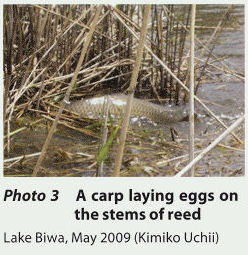 |
5) We developed a non-invasive method (i.e. a method that does not require
handling fish) to quantify
how water conditions stress carp. Using this method we found that changes
in water temperature do
induce stress.
6) We applied a Based on our assessment of KHV disease in Lake Biwa, we
applied our conceptual model
of linked environment-pathogen-human interactions to Lake Erhai, China,
schistosomiasis in Kenya,
fish diseases in the Ping River at Chaing Mai, Thailand (Photo 4), and
Legionella disease (Yamaguchi et
al., 2010), MRSA, Norovirus disease, and nontuberculous mycobacteria disease
(Ichijo et al., 2010) in
Japan. These applications helped us understand how pathogens interact with humans and suggested
enviromental conditions that might prevent disease outbreaks and spread
as well asstrategies for safe
coexistence of humans with pathogens.
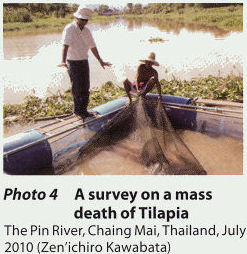 |
7) By combining the results from each work group, ranging from molecular
biology to envirnmental
sciences to human society, we are providing evidence to support the hypothesis
that anthropogenic
encironmental changes promote disease outbreaks.
8) We have presented our findings at national and international conferences
of the linkages between the
environment, pathogens and humans, emphsizing their significance to preventionand control of
infectious disease.
|
|
<Research background and objectives>
The rapid spread of emerging infectious diseases is a serious global environmental
problem that is not only threatening humans, wildlife, and livestock worldwide,
but also inducing economical loss and collapse of ecosystems. This project
has study has three objectives, in the following successive order:
(1) To verify the hypothesis that anthropogenic environmental changes mediate disease outbreaks and spread by analyzing the lakeshore degradation- koi herpesvirus (KHV)–human linkage as a case study, and develop a conceptual infectious disease model of the environment-pathogen–human linkage (Figs. 1 and 2),
(2) To describe the link between the environment, pathogens, and humans
for other infectious diseases based on the conceptual infectious disease
model derived from KHV disease (Fig. 2) in order to understand the common
structure of disease outbreaks,
(3) To suggest how interactions between pathogens and humans can be modified
to prevent disease outbreaks and mitigate the human and environmental damage
associated with infectious diseases to realize a long-term societal security.
(Fig. 2).
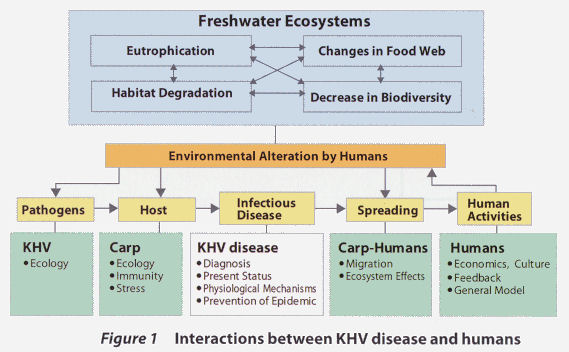
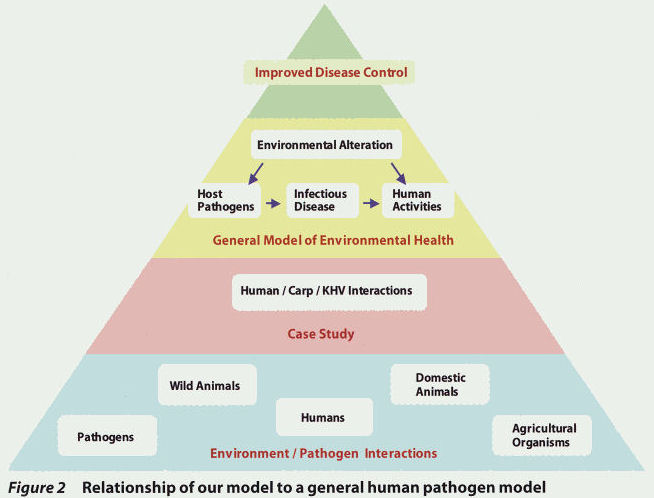 |
<The most significant findings or outcomes of the study>
Specific significant outcomes are as follows:
1) Innovative methods were established to describe the environment–pathogen–human
linkage.
2) We partially verified the hypothesis that anthropogenic alterations of the environment facilitate infectious diseases.
3) The conceptual infectious disease model of the environment–pathogen–human
linkage derived from KHV disease in Lake Biwa was applicable to other infectious
disease cases.
4) We showed that it was impossible to eradicate KHV. Thus, precautionary
environmental management is needed to eliminate “fertile” disease environments
to alleviate human and environmental damage associated with infectious
disease.
<Research Communications>
We shared our research outputs with international and national academic communities and society.
The concept of the environment–pathogen–human linkage was introduced to academic communities and society by publishing a general paper (Kawabata et al., 2011) and more than 30 papers on individual subjects involved in the linkage, editing 10 special articles (Kawabata 2011; Kawabata 2011) for an international journal, organizing five international conferences and presenting at these events. These activities formed the base of an international alliance of researchers to study ‘environmental diseases’ (Environment–pathogen–human–linkage) and promote activities that could help alleviate infectious diseases worldwide.
|
|
*Other research work see "here", please.
|
|







